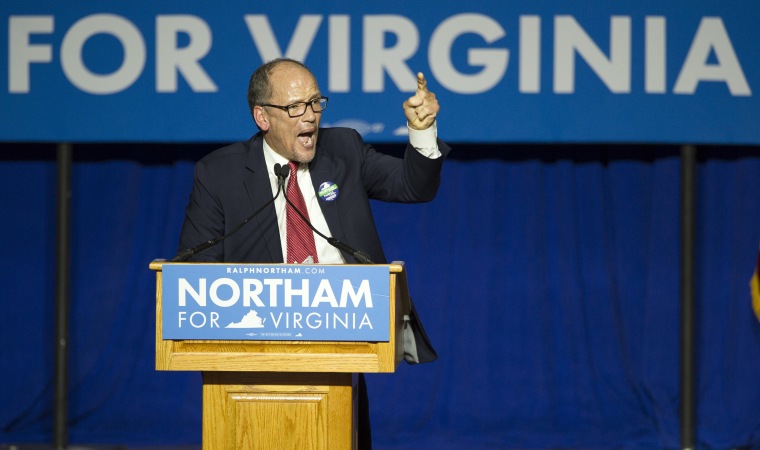WASHINGTON — The Democratic blowouts in Virginia and elsewhere have party officials reaching for superlatives and studying their playbooks ahead of next year's midterm elections as they found themselves in an unfamiliar situation: winning.
"The America that Donald Trump left when he went to South Korea bears little resemblance to the America that he will return to because he has gotten a shot across the bow," Democratic National Committee chair Tom Perez told NBC News. "The formula for success (Tuesday night) is the formula for success we're using everywhere."
After coming up short in all of this year's special congressional elections, and spending as much time fighting with each other as with Republicans, the party is finally starting to see Trump's unpopularity pay off at the ballot box.
Democrats carried Virginia's gubernatorial race by an unexpected 9-point margin, ran the table on the state's House of Delegates races, scooped up the governor's mansion in New Jersey, gained full control of Washington state government, swept municipal elections in a half-dozen states, and won a referendum in Maine to expand Medicaid.
Here are some key lessons Democrats plan to take away:
Ride the wave
Virginia's outgoing governor, Terry McAuliffe, a former national Democratic Party chair himself, said the results Tuesday would bring donors, candidates and activists off the bench and re-energize the party at a time when it needed it most.
"Everyone was looking to Virginia and, boy, this was not a lift, this was a jet takeoff," he told reporters.
Half of Virginia voters said Trump was a factor in their vote, and those who did said they oppose the president by a 2-to-1 margin, according to exit polls. In addition, turnout was way up over McAulliffe's election in 2013, showing enthusiasm among party voters.
"The strength of 'The Resistance' is at tidal wave proportions," said Adam Green, the co-founder of the Progressive Change Campaign Committee.
Democrats had been concerned about black voters after some unforced errors by Northam's campaign, but turnout and Democratic support held roughly steady from 2016.
Play the field
Rep. Ben Ray Luján of New Mexico, who chairs the campaign arm of Democrats in the House, said he spent Tuesday night on the phone with candidates across the country telling them to turn on their TVs to watch and learn.
"What we saw the Democrats do down in Virginia was be very aggressive in expanding their battlefield," Lujan said.
A Trump-enabled outpouring of new candidates helped Virginia Democrats compete in more races than ever — including some they had written off in previous years.
Nationally, House Democrats are following a similar strategy, putting as many as 80 congressional districts in play, which they hope will give them lots of chances to get lucky if things line up like they did on Tuesday.
"The House is absolutely in play," Luján said. "We’re going to pick up seats. It’s just a matter of how many."
Rockin' the suburbs
Northam’s victory was powered by the same wealthy, educated white suburban voters who broke away from Trump last year and who made the special congressional election in Georgia's 6th District earlier this year competitive — only more so.
Meanwhile, Democrats ousted GOP county executives in two large counties outside New York City, Nassau and Westchester, suggesting the backlash is not limited to government workers who live in northern Virginia.
That's a big problem for Republicans, who have counted on suburban voters as a pillar of their coalition.
Youth vote
Hillary Clinton famously struggled with young voters, but Northam did not. Preliminary results suggests he dominated millennials, the largest generation in the country, and that could point to more victories for Democrats in the future.
"I think that Nov. 8, 2016, was a wake-up call to young people about the importance of voting," Tom Steyer, the liberal billionaire who spent some $2 million on a voter mobilization effort aimed at young people in Virginia, told NBC News. "They've spent 10 months in horror watching what’s going on in the United States."
Right candidate, right message
While Democrats had plenty of criticism of Northam's tactics heading into election night, everyone agreed the Army veteran and pediatrician was hard to dislike.
"People responded to the positive message," said Rep. Bobby Scott, D-Va.
No one said that about Clinton last year, whose unpopularity lead many voters to hold their nose and vote for Trump, post-election surveys suggest.
Meanwhile, Northam and other Democrats capitalized on the unpopular aspects of the GOP agenda in nearby Washington, especially the failed attempt to repeal the Affordable Care Act, exit polls suggest.
"Republicans lost by more than 50 points on the No. 1 issue to voters — health care," said Democratic strategist Jesse Ferguson, who has worked on Virginia races.
